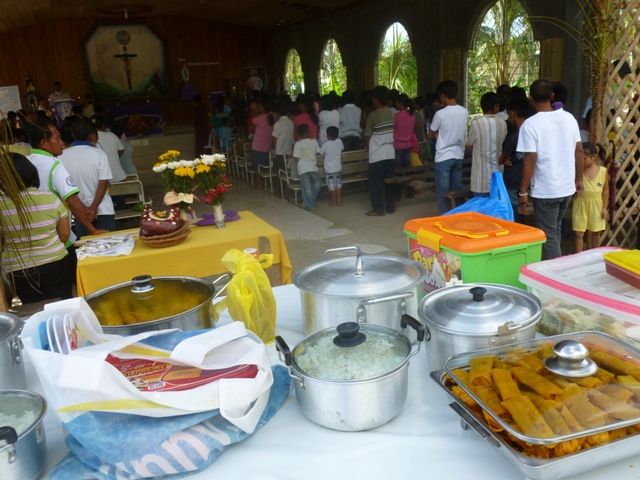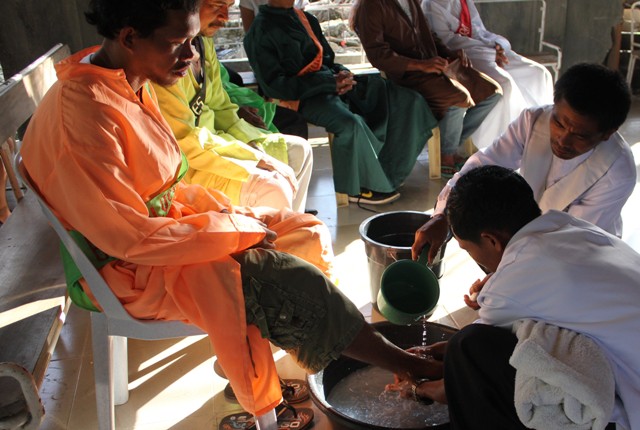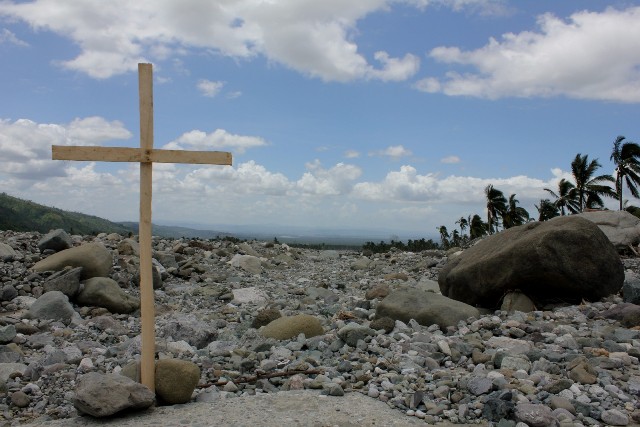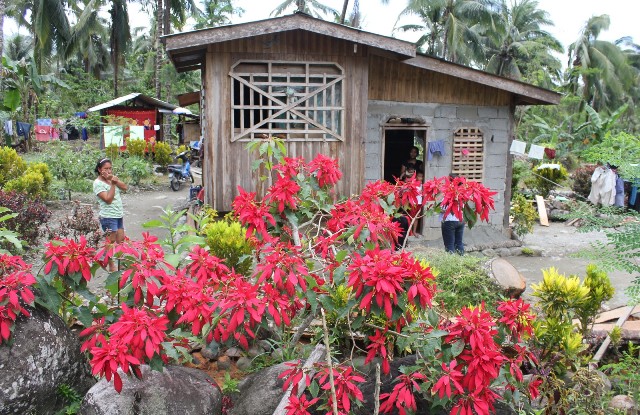NEW BATAAN, Compostela Valley (MindaNews/29 March) – On the long table outside the San Roque chapel in Barangay Andap on Maundy Thursday afternoon, cooking pots and plastic containers of food brought by residents – rice, pancit, lumpia, roasted chicken, among others – waited for the end of the “washing of the feet” ritual so that “Jesus” and the 12 “apostles” — and the rest of the community – could partake of the “Last Supper.”
It is a ritual residents do ever Holy Week here and one that they vowed to continue doing even if hundreds of their neighbors are no longer around, physically, to share it with — their names written down on a tarpaulin on the left side of the altar – they who did not survive super typhoon Pablo.
“Mas puno talaga ito last year, hanggang dito sa labas,” (This was really full last year, spilling over, outside), 43-year old Dionisia Requinto, said of last year’s ritual.
 Residents’ contributions for the “Last Supper” after the “washing of the feet” ritual on Maundy Thursday in Barangay Andap, New Bataan. MindaNews photo by Carolyn O. Arguillas
Residents’ contributions for the “Last Supper” after the “washing of the feet” ritual on Maundy Thursday in Barangay Andap, New Bataan. MindaNews photo by Carolyn O. Arguillas
It was in this chapel early morning of December 4, 2012 where residents sought refuge at the height of typhoon Pablo, many of them climbing to the ceiling, witnessing the horrors and hearing the screams of their neighbors whose houses were swept away by a debris flow of water, mud, tree trunks, rocks and boulders.
The chapel is the last remaining functioning structure on the right side of the road. The rest of the structures of the poblacion (village center) — houses, barangay hall, health center, elementary school, resorts, the highway to Maragusan town as well as trees and farmlands – were buried under what the Mines and Geo-Sciences regional bureau estimated as five-meter (16.4 feet) deep debris of rocks and boulders, stretching about a kilometer wide and flowing all the way down to Barangay Cogonon some 10 kilometers away.
Barangay Andap was the hardest hit among the areas struck by Pablo and had the most number of dead and missing – at least 430 out of the 612 killed in Compostela Valley province. According to the records of the National Disaster Risk Reduction and Management Council, Pablo claimed the lives of 1,067 persons in eight regions nationwide.
Requinto, who lost six relatives and whose house was among those buried, couldn’t control her tears as she recalled last year’s Maundy Thursday.
 Kaabag (lay leader) Lando Fernandez performs Jesus Christ’s washing of the feet ritual at the San Roque chapel in Barangay Andap, New Bataan town in Compostela Valley province on Maundy Thursday, March 28. Andap was the hardest hit among areas struck by super typhoon Pablo on December 4, 2012. MindaNews photo by Toto Lozano
Kaabag (lay leader) Lando Fernandez performs Jesus Christ’s washing of the feet ritual at the San Roque chapel in Barangay Andap, New Bataan town in Compostela Valley province on Maundy Thursday, March 28. Andap was the hardest hit among areas struck by super typhoon Pablo on December 4, 2012. MindaNews photo by Toto Lozano
Asked if the 12 “apostles” whose feet were washed by Kaabag (lay leader) Lando Fernandez were the same as last year, Requinto shook her head. Three “apostles” in last year’s ritual, did not survive Pablo, she said.
Along the road near the chapel, wooden crosses were set up in strategic areas. Residents volunteered these were for the traditional Stations of the Cross ritual on Good Friday.
“What is the route? Where is the last station,” MindaNews asked.
 Wooden crosses have been set up in strategic areas near the chapel in Barangay Andap, New Bataan in Compostela Valley province for the annual Good Friday Stations of the Cross. MindaNews photo by Toto Lozano
Wooden crosses have been set up in strategic areas near the chapel in Barangay Andap, New Bataan in Compostela Valley province for the annual Good Friday Stations of the Cross. MindaNews photo by Toto Lozano
“Sa daang dalan” (the old road), a store vendor said. The “daang dalan” is the New Bataan-Maragusan concrete road, portions of which had been buried by rocks and boulders.
Requinto said the Good Friday ritual was scheduled for 7 a.m.
The last station of the cross used to be near the Bamboo Garden Resort, one of many resorts that are but a memory now, having been buried as well by the debris flow. But the cluster in the GKK or Basic Ecclesial Community that in charge of the ritual, moved the last station several meters away “kay grabe na ang bato didto” (because the area is so rocky now).
Dr. Gail Ilagan, Director of the Center of Psychological Extension and Research Services (COPERS) of the Ateneo de Davao University said community rituals “are important to post-disaster psychosocial recovery.”
“These rituals are natural mechanisms for the community to come to terms with who and what were lost by the disruption and to symbolize that they come together to carry on,” said Ilagan, who writes a column for MindaNews and who joined the MindaNews team in Barangay Andap last Thursday.
“Rituals are for community cohesion, to heal. Rituals cannot be forced. The people themselves know when it’s time,” Ilagan added.
It has been four months since Pablo struck but a number of residents continue to live in tents in New Bataan town, either in the tent city inside a public high school compound or across the public cemetery in the poblacion, and in some areas in Barangay Andap where Requinto presently lives.
Fronting the tent city inside the school compound is a row of eight bunkhouses at nine units each, the home for at least 72 families since February 15.
Uncertainty remains, particularly for those who are still living in tents and awaiting relocation. The relief assistance government promised the survivors for six months since December, will end in two months.
Relief goods from private institutions are getting fewer and far between although a team from the Gamma Phi Omicron arrived in Barangay Andap from a relief distribution in neighboring Compostela town, and left behind four sacks of two-kilo rice packs for distribution after Thursday’s ritual.
Kidapawan City-based Flora Gabunales, Gamma’s national president, said they brought a total of 70 sacks of rice, noodles to Compostela Valley province and their last stop was Andap.
Fr. Edgardo Tuling, parish priest of San Antonio de Padua in downtown New Bataan said they continue to focus on livelihood, on planting vegetables and other short-term crops so the displaced residents can fend for themselves when the rations stop.
In Barangay Andap, a number of the farmlands had been buried and residents still await relocation.
But in that wide expanse of rocks and boulders on this Maundy Thursday afternoon, banana plants could be seen jutting out of the spaces between the rocks.
 Poinsettias are a common sight during Christmas season but in Barangay Andap in New Bataan, Compostela Valley, they are a welcome sight at summer. Baranga Andap was the hardest hit village when super typhoon Pablo struck last December 4. MindaNews photo by Toto Lozano
Poinsettias are a common sight during Christmas season but in Barangay Andap in New Bataan, Compostela Valley, they are a welcome sight at summer. Baranga Andap was the hardest hit village when super typhoon Pablo struck last December 4. MindaNews photo by Toto Lozano
And on both sides of the road leading to the devastation, visitors are welcomed by a profusion of poinsettias in bloom.
Residents of Barangay Andap say there is nothing extraordinary about poinsettias in bloom in the summer in this mountain resort village but no one remembers if these flowers in deep red, bloomed Christmas of 2012.
“We were not here. We evacuated to Davao City,” said Madeline.
Nini Paderog of Purok 15, whose front yard is lined with poinsettia trees, said she was in Manila tending to an ailing husband when typhoon Pablo hit their village.
Along the six-kilometer stretch to the chapel from downtown New Bataan, no visitor could miss the profusion of poinsettias in bloom, like Christmas had finally come to Andap at Easter. (Carolyn O. Arguillas/MindaNews)
